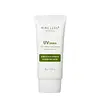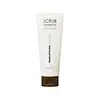What's inside
What's inside
 Key Ingredients
Key Ingredients

 Benefits
Benefits

 Concerns
Concerns

 Ingredients Side-by-side
Ingredients Side-by-side

Water
Skin ConditioningAcrylates Copolymer
Butylene Glycol
HumectantEthylhexyl Palmitate
EmollientButyloctyl Salicylate
Skin ConditioningGlycerin
HumectantEthylhexyl Triazone
UV AbsorberDiethylamino Hydroxybenzoyl Hexyl Benzoate
UV Filter1,2-Hexanediol
Skin ConditioningNiacinamide
SmoothingDicaprylyl Carbonate
EmollientC14-22 Alcohols
Emulsion StabilisingCetearyl Olivate
Bis-Ethylhexyloxyphenol Methoxyphenyl Triazine
Skin ConditioningVinyl Dimethicone/Methicone Silsesquioxane Crosspolymer
Sorbitan Olivate
EmulsifyingPoly C10-30 Alkyl Acrylate
Emulsion StabilisingC12-20 Alkyl Glucoside
EmulsifyingMethyl Glucose Sesquistearate
EmollientPolyacrylate Crosspolymer-6
Emulsion StabilisingCetearyl Alcohol
EmollientGlyceryl Stearate Se
EmulsifyingPrunus Amygdalus Amara Kernel Oil
MaskingHedera Helix Leaf/Stem Extract
AntimicrobialAdenosine
Skin ConditioningPyrus Malus Fruit Extract
Skin ConditioningDisodium EDTA
Stearic Acid
CleansingT-Butyl Alcohol
PerfumingVanilla Planifolia Fruit Extract
Skin ConditioningJasminum Officinale Flower Water
MaskingGlucose
HumectantMacadamia Ternifolia Seed Oil
EmollientCaprylic/Capric Triglyceride
MaskingPropanediol
SolventHyaluronic Acid
HumectantTocopherol
AntioxidantBrassica Campestris Sterols
EmollientCholesterol
EmollientPhytosteryl/Behenyl/Octyldodecyl Lauroyl Glutamate
Skin ConditioningPhenoxyethanol
PreservativeCentella Asiatica Extract
CleansingPolyglyceryl-10 Oleate
Skin ConditioningHydrogenated Lecithin
EmulsifyingCeramide NP
Skin ConditioningPotassium Cetyl Phosphate
EmulsifyingBeta-Glucan
Skin ConditioningEthylhexylglycerin
Skin ConditioningMorinda Citrifolia Extract
AstringentCamellia Sinensis Leaf Extract
AntimicrobialHouttuynia Cordata Extract
Skin ConditioningMelaleuca Alternifolia Leaf Extract
PerfumingPetroselinum Sativum Extract
Skin ConditioningMentha Piperita Leaf Extract
Skin ConditioningHippophae Rhamnoides Fruit Extract
Skin ConditioningAureobasidium Pullulans Ferment
Skin ConditioningCeramide Ns
Skin ConditioningCeramide EOP
Skin ConditioningWater, Acrylates Copolymer, Butylene Glycol, Ethylhexyl Palmitate, Butyloctyl Salicylate, Glycerin, Ethylhexyl Triazone, Diethylamino Hydroxybenzoyl Hexyl Benzoate, 1,2-Hexanediol, Niacinamide, Dicaprylyl Carbonate, C14-22 Alcohols, Cetearyl Olivate, Bis-Ethylhexyloxyphenol Methoxyphenyl Triazine, Vinyl Dimethicone/Methicone Silsesquioxane Crosspolymer, Sorbitan Olivate, Poly C10-30 Alkyl Acrylate, C12-20 Alkyl Glucoside, Methyl Glucose Sesquistearate, Polyacrylate Crosspolymer-6, Cetearyl Alcohol, Glyceryl Stearate Se, Prunus Amygdalus Amara Kernel Oil, Hedera Helix Leaf/Stem Extract, Adenosine, Pyrus Malus Fruit Extract, Disodium EDTA, Stearic Acid, T-Butyl Alcohol, Vanilla Planifolia Fruit Extract, Jasminum Officinale Flower Water, Glucose, Macadamia Ternifolia Seed Oil, Caprylic/Capric Triglyceride, Propanediol, Hyaluronic Acid, Tocopherol, Brassica Campestris Sterols, Cholesterol, Phytosteryl/Behenyl/Octyldodecyl Lauroyl Glutamate, Phenoxyethanol, Centella Asiatica Extract, Polyglyceryl-10 Oleate, Hydrogenated Lecithin, Ceramide NP, Potassium Cetyl Phosphate, Beta-Glucan, Ethylhexylglycerin, Morinda Citrifolia Extract, Camellia Sinensis Leaf Extract, Houttuynia Cordata Extract, Melaleuca Alternifolia Leaf Extract, Petroselinum Sativum Extract, Mentha Piperita Leaf Extract, Hippophae Rhamnoides Fruit Extract, Aureobasidium Pullulans Ferment, Ceramide Ns, Ceramide EOP
Water
Skin ConditioningPerlite
AbsorbentAmmonium Laureth Sulfate
CleansingGlycerin
HumectantCocamidopropyl Betaine
CleansingAmmonium Lauryl Sulfate
CleansingAcrylates Copolymer
Sodium Chloride
MaskingMentha Arvensis Leaf Oil
MaskingDipropylene Glycol
HumectantSodium Benzoate
MaskingPotassium Hydroxide
BufferingHydroxyacetophenone
Antioxidant1,2-Hexanediol
Skin ConditioningButylene Glycol
HumectantAmmonium Sulfate
Laureth-3
EmulsifyingLauryl Alcohol
EmollientDisodium EDTA
Centella Asiatica Extract
CleansingPolygonum Cuspidatum Root Extract
AntioxidantScutellaria Baicalensis Root Extract
AstringentCamellia Sinensis Leaf Extract
AntimicrobialGlycyrrhiza Glabra Root Extract
BleachingChamomilla Recutita Flower Extract
MaskingRosmarinus Officinalis Leaf Extract
AntimicrobialLimonene
PerfumingWater, Perlite, Ammonium Laureth Sulfate, Glycerin, Cocamidopropyl Betaine, Ammonium Lauryl Sulfate, Acrylates Copolymer, Sodium Chloride, Mentha Arvensis Leaf Oil, Dipropylene Glycol, Sodium Benzoate, Potassium Hydroxide, Hydroxyacetophenone, 1,2-Hexanediol, Butylene Glycol, Ammonium Sulfate, Laureth-3, Lauryl Alcohol, Disodium EDTA, Centella Asiatica Extract, Polygonum Cuspidatum Root Extract, Scutellaria Baicalensis Root Extract, Camellia Sinensis Leaf Extract, Glycyrrhiza Glabra Root Extract, Chamomilla Recutita Flower Extract, Rosmarinus Officinalis Leaf Extract, Limonene
 Reviews
Reviews

Alternatives
Ingredients Explained
These ingredients are found in both products.
Ingredients higher up in an ingredient list are typically present in a larger amount.
1,2-Hexanediol is a synthetic liquid and another multi-functional powerhouse.
It is a:
- Humectant, drawing moisture into the skin
- Emollient, helping to soften skin
- Solvent, dispersing and stabilizing formulas
- Preservative booster, enhancing the antimicrobial activity of other preservatives
Acrylates Copolymer is used as a film-forming agent and texture enhancer.
After applied, Acrylates Copolymer forms a thin film cover that helps skin feel more soft. It can help sunscreens become more water-resistant.
It is also used to make a product more thick.
Learn more about Acrylates CopolymerButylene Glycol (or BG) is used within cosmetic products for a few different reasons:
Overall, Butylene Glycol is a safe and well-rounded ingredient that works well with other ingredients.
Though this ingredient works well with most skin types, some people with sensitive skin may experience a reaction such as allergic rashes, closed comedones, or itchiness.
Learn more about Butylene GlycolCamellia Sinensis Leaf Extract is derived from the leaves of the tea plant. Black tea, green tea, and oolong tea are all harvested from this plant.
This ingredient has many skin benefits:
This ingredient contains polyphenols, a strong antioxidant. Antioxidants help fight off molecules that damage skin cells.
On top of that, the antioxidants in green tea neutralize free-radicals from the sun. This gives the skin some extra UV protection, but should not replace sunscreen.
Many components of tea have anti-inflammatory properties.
Polyphenols and L-theanine help soothe the skin and reduce irritation. The caffeine in Camellia Sinensis Leaf Extract helps calm inflamed blood vessels.
Other compounds found in tea include: Vitamin Bs, linoleic acid, magnesium, calcium, iron, and zinc.
Research has shown both drinking Camellia Sinensis Leaf Tea and applying it to the skin can help boost skin elasticity and hydration. Studies also show using tea extract may reduce sebum, or oil, production.
Learn more about Camellia Sinensis Leaf ExtractCentella Asiatica Extract (Centella) is derived from an herb native to Southeast Asia. It is famous for its anti-inflammatory and soothing properties.
Centella is rich in antioxidants and amino acids, such as Madecassic Acid and Asiaticoside.
Studies show the compounds in centella help with:
The combination of all these properties makes centella effective at soothing, hydrating, and protecting the skin.
Other great components of centella include Vitamin A, vitamin C, several B vitamins, and Asiatic Acid.
Fun fact: Centella has been used as a medicine and in food for many centuries. As a medicine, it is used to treat burns, scratches, and wounds.
Learn more about Centella Asiatica ExtractDisodium EDTA plays a role in making products more stable by aiding other preservatives.
It is a chelating agent, meaning it neutralizes metal ions that may be found in a product.
Disodium EDTA is a salt of edetic acid and is found to be safe in cosmetic ingredients.
Learn more about Disodium EDTAGlycerin is already naturally found in your skin. It helps moisturize and protect your skin.
A study from 2016 found glycerin to be more effective as a humectant than AHAs and hyaluronic acid.
As a humectant, it helps the skin stay hydrated by pulling moisture to your skin. The low molecular weight of glycerin allows it to pull moisture into the deeper layers of your skin.
Hydrated skin improves your skin barrier; Your skin barrier helps protect against irritants and bacteria.
Glycerin has also been found to have antimicrobial and antiviral properties. Due to these properties, glycerin is often used in wound and burn treatments.
In cosmetics, glycerin is usually derived from plants such as soybean or palm. However, it can also be sourced from animals, such as tallow or animal fat.
This ingredient is organic, colorless, odorless, and non-toxic.
Glycerin is the name for this ingredient in American English. British English uses Glycerol/Glycerine.
Learn more about GlycerinWater. It's the most common cosmetic ingredient of all. You'll usually see it at the top of ingredient lists, meaning that it makes up the largest part of the product.
So why is it so popular? Water most often acts as a solvent - this means that it helps dissolve other ingredients into the formulation.
You'll also recognize water as that liquid we all need to stay alive. If you see this, drink a glass of water. Stay hydrated!
Learn more about Water